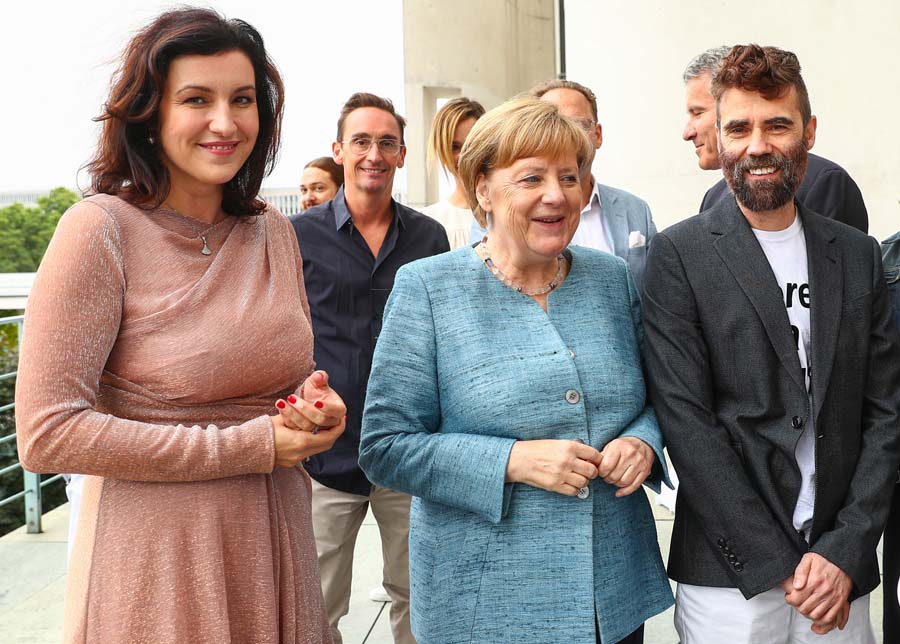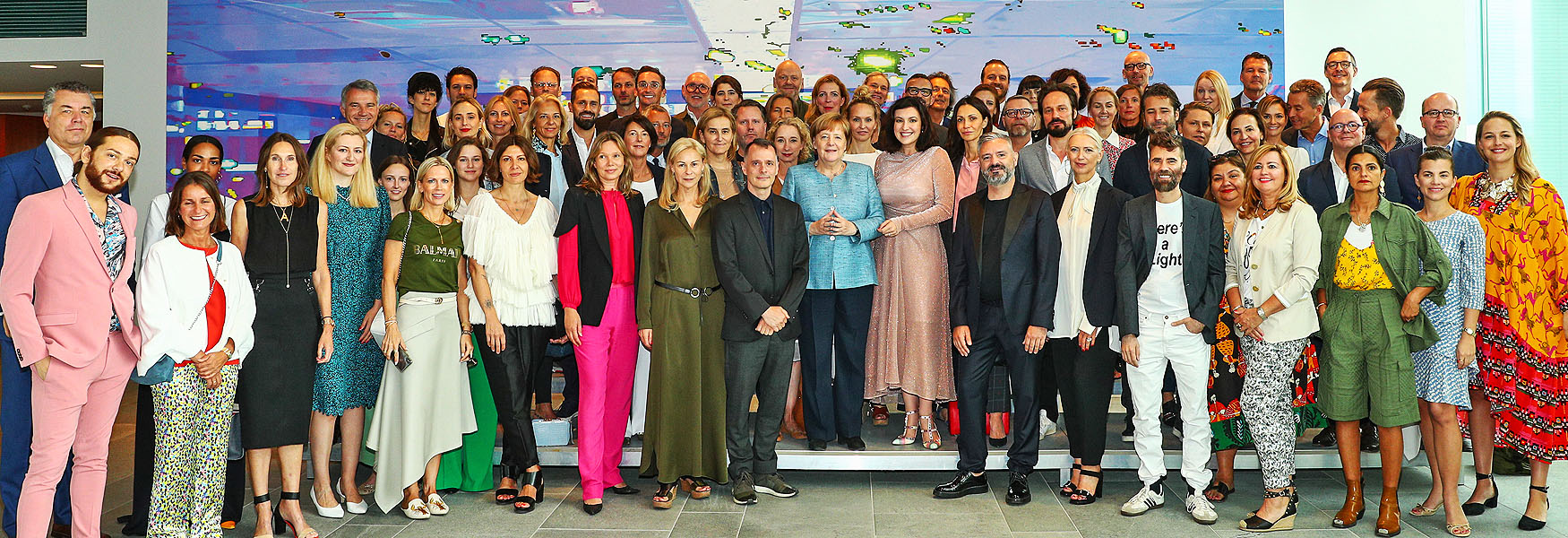Fashion Council Germany und Angela Merkel
Von Holger Jacobs
09.07.2018
English text below
Wertung: 🙂 🙂 🙂 🙂 🙂 (fünf von fünf)
Jetzt ist die Deutsche Mode im Kanzleramt angekommen.
In Ländern wie Italien und Frankreich ist die Modewirtschaft schon lange ein nationales Kulturgut. Anfang der 80er Jahre hatte der damalige französische Präsident Francois Mitterand die Operation „Les Grands Travaux (Grands projets culturels)“ lanciert mit dem Ziel, die wichtigsten Symbole der Französischen Kultur neu zu bewerten und zu gestalten. Im Laufe dieser Operation, die ca. 10 Jahre dauerte, wurden der Louvre, das größte Museum der Welt, komplett renoviert, eine neue Bibliothèque Nationale am Seine Ufer gebaut, das Grand Palais (wo Chanel jetzt immer seine Kollektionen zeigt) renoviert, die Grand Arche (als Achse Louvre-Arc-de-Triomphe – La Defense) gebaut, die Figuren der Pont Alexandre III. neu mit Blattgold belegt, et.c. Man schätzt die Gesamtkosten auf ca. 70 Milliarden Francs (ca. 23 Milliarden Euro), wahrscheinlich liegt die Summe wesentlich höher.
Innerhalb dieser Aktion für die französische Kultur wurden auch neue Veranstaltungssäle für die Präsentationen der Prêt-à-porter und der Haute-Couture unter dem Louvre gebaut. Drei längliche Hallen mit variablen Kapazitäten für 200 bis 1000 Besucher. Ideal, um Modenschauen abzuhalten.
Im Gegensatz zu Italien und Frankreich ist Deutschland von der Automobilwirtschaft beherrscht. Hier wurden im Jahre 2017 insgesamt 426 Milliarden Euro umgesetzt, zu ca. 69 Milliarden in der Textilwirtschaft.
Frankreich setzt dagegen ca. 150 Milliarden Euro in der Textilwirtschaft um, Italien ca. 80 Milliarden.
Trotzdem sollte auch in Deutschland die Modeindustrie den Stellenwert bekommen, den sie verdient.
Den Anfang dazu machte im Januar 2015 eine Gruppe von Modeexpertinnen, darunter die Chefin der deutschen Vogue, Christiane Arp, sowie Anita Tillmann, CEO der PREMIUM Modemesse und Marie-Louise Berg, Inhaberin der renommierten PR-Agentur Berg Communications, und gründeten den FASHION COUNCIL GERMANY (FCG). Das Ziel war zunächst, zusammen mit der Berliner Senatsverwaltung für Wirtschaft, Technologie und Forschung, ein Mentoring Programm für junge Nachwuchstalente ins Leben zu rufen. Die ersten beiden „Mentees“ waren Nobieh Talai und Marina Hoermanseder.

7 Photos: Staatsministerin Dorothee Bär, Angela Merkel und Designer Lutz Huelle, Bundeskanzleramt © FCG
Mittlerweile hat sich der Aufgabenbereich des FASHION COUNCIL GERMANY deutlich erweitert. Mehr und mehr unterliegt die gesamte Organisation der Berlin Fashion Week jetzt dem Council. Gleichzeitig wird sie zum wichtigsten Lobbyisten der Branche.
Aus dieser Funktion heraus kam es am vergangenen Freitag zu einem ersten Treffen des FASHION COUNCIL GERMANY im Bundeskanzleramt mit der Staatsministerin für Digitalisierung, Dorothee Bär. Und der FCG brachte viele weitere wichtige Persönlichkeiten der deutschen Modebranche mit, so u.a. Detlev Braun (Messe Frankfurt), Florian Braun (Unger), Gabriele Castegnaro (Kohnen), John Cloppenburg (Peek & Cloppenburg), Otto Drögsler und Jörg Ehrlich (Odeeh), Dr. Christian Ehler (Mitglied des Europäischen Parlaments), Anna Heinrichs (Horror Vacui), Lutz Huelle (Modedesigner in Paris), Markus Höhn (Loden-Frey), Alfons Kaiser (Frankfurter Allgemeine Zeitung), Nina Kuhn und Rianna Nektaria Konou (Rianna + Nina), Marcus Kurz (Nowadays und Vorstandsmitglied FCG), Jürgen Leuthe (Luisa Cerano), André Maeder (KaDeWe Group), Anne Meyer-Minnemann (Gala), Katja Ohly-Nauber (Mercedes-Benz), Leyla Piadayesh (Lala Berlin), Adrian Runhof und Johnny Talbot (Talbot Runhof), Anita Tillmann (PREMIUM Group und Vorstandsmitglied FCG), Dorothee Schumacher, Moritz von Laffert (Condé Nast), Elisabeth von Thurn und Taxis (Vogue.com), Ingo Wilts (Hugo Boss).
Zur großen Freude aller Beteiligten schaute Bundeskanzlerin Angela Merkel kurz vorbei, die dann auch verschmitzt bemerkte, dass „ihre“ Dorothee Beer aber am Morgen bei der Kabinettsbesprechung ein weniger gewagtes Kleid getragen hätte (sexy Cocktailkleid im Nude-Ton, überall mit Strasssteinen bestickt)…
VOGUE-Chefin Christiane Arp erzählte von diesem Treffen später anlässlich der Eröffnung des BERLINER SALONS und VOGUE SALONS im Kronprinzenpalais. Das Statement von Christiane Arp findet Ihr hier auf unserem Youtube Kanal KULTUR24 TV
Selbst wenn die Automobilwirtschaft auch in Zukunft Deutschlands Nummer 1 im Umsatz bleiben wird, so ist doch zu wünschen, dass auch der Kreativwirtschaft die entsprechende politische Würdigung zuteilwird. Deutschland hat nicht nur geniale Erfinder in der Technologie, sondern auch großartige Köpfe in Kunst und Kultur – weshalb u.a. das online Kulturmagazin kultur24.berlin vor vier Jahren gegründet wurde!
Fazit: Bleiben wir optimistisch und erfreuen wir uns an den vielen schönen Dingen, die uns kreative Menschen in Deutschland offerieren, um uns damit den Alltag zu verschönern. Und zollen wir ihnen Respekt!
Der BERLINER SALON und VOGUE SALON im Kronprinzenpalais:
english text
Fashion Council Germany and Angela Merkel
By Holger Jacobs
09/07/2018
Now the German fashion arrived at the Chancellery.
In countries such as Italy and France, the fashion industry has long been a national cultural asset. In the early 1980s, French President Francois Mitterand launched the operation Les Grands Travaux (Grands projets culturels) with the aim of re-evaluating and shaping the most important symbols of French culture. In the course of this operation, which lasted about 10 years, the Louvre, the largest museum in the world, was completely renovated, a new Bibliothèque Nationale was built near to the Seine, the Grand Palais (where Chanel now always shows his collections), the Grand Arche (built as axis Louvre-Arc-de-Triomphe – La Defense), the figures of Pont Alexandre III. new painted with gold leaf, et.c. The total cost is estimated at about 70 billion francs (about 23 billion euros), probably the sum is much higher.
As part of this campaign for French culture, new venues for the presentation of prêt-à-porter and haute couture under the Louvre have also been built. Three elongated halls with variable capacities for 200 to 1000 visitors. Ideal for holding fashion shows.
Unlike Italy and France, Germany is dominated by the automotive industry. In 2016, a total of 426 billion euros were transacted here, to about 69 billion in the textile industry.
France, on the other hand, realizes about 150 billion euros in the textile industry, Italy about 80 billion.
Nevertheless, the fashion industry in Germany should get the status that it deserves.
It all started in January 2015 with a group of fashion experts, including the head of German Vogue, Christiane Arp, and Anita Tillmann, CEO of the PREMIUM fashion fair, and Marie-Louise Berg, owner of the renowned PR agency Berg Communications, and founded the FASHION COUNCIL GERMANY (FCG). The goal was initially, together with the Berlin Senate Department for Economics, Technology and Research, to launch a mentoring program for young talents. The first two mentees were Nobieh Talai and Marina Hoermanseder.
Meanwhile, the scope of the FASHION COUNCIL GERMANY has expanded significantly. More and more, the entire organization of the Berlin Fashion Week is now subject to the Council. At the same time, it becomes the most important lobbyist in the fashion industry.
This function led to a first meeting of the FASHION COUNCIL GERMANY at the Federal Chancellery last Friday with the Minister of State for Digitization, Dorothee Beer. And the FCG brought many other important personalities of the German fashion industry, such as Detlev Braun (Messe Frankfurt), Florian Braun (Unger), Gabriele Castegnaro (Kohnen), John Cloppenburg (Peek & Cloppenburg), Otto Drögsler and Jörg Ehrlich (Odeeh), dr. Christian Ehler (Member of the European Parliament), Anna Heinrichs (Horror Vacui), Lutz Huelle (fashion designer in Paris), Markus Höhn (Loden-Frey), Alfons Kaiser (Frankfurter Allgemeine Zeitung), Nina Kuhn and Rianna Nektaria Konou (Rianna + Nina ), Marcus Kurz (Nowadays and Board Member FCG), Jürgen Leuthe (Luisa Cerano), André Maeder (KaDeWe Group), Anne Meyer-Minnemann (Gala), Katja Ohly-Nauber (Mercedes-Benz), Leyla Piadayesh (Lala Berlin), Adrian Runhof and Johnny Talbot (Talbot Runhof), Anita Tillmann (PREMIUM Group and board member FCG), Dorothee Schumacher, Moritz von Laffert (Condé Nast), Elisabeth von Thurn and Taxis (Vogue.com), Ingo Wilts (Hugo Boss).
To the great delight of all parties Chancellor Angela Merkel looked over briefly, then mischievously noticed that „her“ Dorothee Beer had worn in the morning at the cabinet meeting a less daring dress (sexy cocktail dress in the nude tone, everywhere embroidered with rhinestones ) …
German VOGUE editor-in-chief Christiane Arp told about this meeting later on the occasion of the opening of the BERLINER SALON and VOGUE SALON in the Kronprinzenpalais.
Even if the automotive industry will continue to be Germany’s number one in terms of sales in the future, it is to be hoped that the creative industries will also receive the appropriate political appreciation. Germany not only has ingenious inventors in technology, but also great minds in art and culture – why u.a. The online cultural magazine kultur24.berlin was founded four years ago!
Conclusion: We remain optimistic and we enjoy the many beautiful things that creative people in Germany offer us to beautify our everyday life. And we pay tribute to them!
Author: Holger Jacobs
Founder & Editorial Director of kultur24.berlin ug.
Founder & Editorial Director of kultur24 TV on Youtube.
Former correspondent for fashion in Paris.
Photographer, writer and filmmaker.












